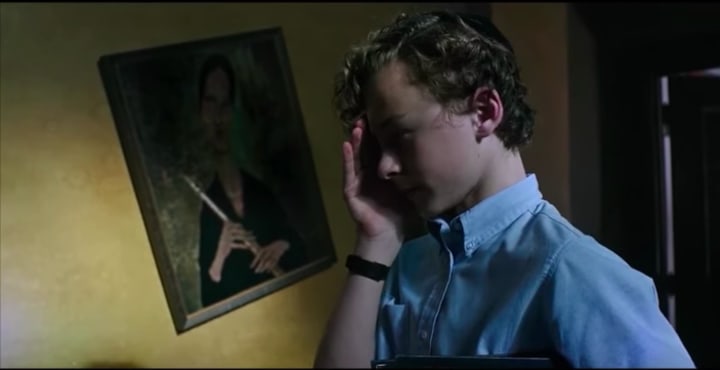The Movie 'It' and Schizoaffective Disorder
'It' by Stephen King is a great portrayal of what it’s like to live with schizoaffective disorder. Here’s a look into scenes from the 2017 movie that portray schizophrenia.

I curled up on the couch, with a blanket and a dog, ready for one of my friend’s favorite movies. He loved the movie It, though I had never seen it. He rented the recent remake, certain that I would love it. About twenty minutes into It, I screamed, turned on all the lights in the house, glared at him, and asked, “What the fuck, dude?!” I wasn’t ready for the schizophrenic trip down memory lane that this screwed up movie was taking me on.
Now, just to warn you, there will be some spoilers up ahead, so if you haven’t seen this messed-up clown movie yet, you might want to save this article for later.
I will also be pulling disturbing images and clips from the movie… so if you’re sensitive to gore or you personally suffer from schizoaffective disorder, this article may be triggering for you.
Before we get to the good stuff, you might be wondering — what in the world is schizoaffective disorder?
From the National Alliance on Mental Illness, schizoaffective disorder looks a little bit like this:
- Hallucinations, which are seeing or hearing things that aren’t there.
- Delusions, which are false, fixed beliefs that are held regardless of contradictory evidence.
- Disorganized thinking. A person may switch very quickly from one topic to another or provide answers that are completely unrelated.
- Depressed mood. If a person has been diagnosed with schizoaffective disorder depressive type they will experience feelings of sadness, emptiness, feelings of worthlessness or other symptoms of depression.
- Manic behavior. If a person has been diagnosed with schizoaffective disorder: bipolar type they will experience feelings of euphoria, racing thoughts, increased risky behavior and other symptoms of mania.
In short, if you take schizophrenia and depression (or bipolar disorder) and mash it together, you get a thing called schizoaffective disorder.
On a more personal note, schizoaffective disorder makes me (just me… I can’t speak for everyone that has schizoaffective disorder since it affects us all differently) terrified of seemingly mundane things.
For example, let’s take the horrifying flute lady scene from It and I’ll paint you a picture of what it’s like to have schizoaffective disorder. (Side-note: this was the scene that made me turn on all the lights and yell at my poor, innocent friend.)

Spoopy!
See that spooky ass lady on the left? The one with the flute? See how the kid is covering his face? Schizoaffective disorder makes me believe that all portraits are terrifying. Paintings are the worst. I grew up with a mother that loved hanging painted portraits in every room. My would eyes distort the imagery and the faces. They became these decomposing, terrifying pieces of nightmares, plastered against the walls of my home.
I could feel their eyes traveling against my skin, as I walked by.
They would breathe a low hum of words I couldn’t understand, into my ears.
I hated those damn portraits.
The worst? When I closed my eyes to go to bed, I swear the portraits would move. They came out of their frames and stood over my bed, watching me. Taunting me.
But really, watching me.
Reading about living with schizoaffective disorder might make you think — alright, so you get hallucinations and you experience things that aren’t real.
You know that these things aren’t real, right?
Sure. They’re not “real.” But to me, with schizoaffective disorder, it’s an eternal conflict of telling my brain that “it isn’t real” when it is there, plain as day, as real as the words that I have written on this post. (Are you hallucinating the words on this post?)
But hey, if you want to experience the terror for yourself, watch this clip from It.
And that’s the reason why, as an adult, my walls are completely barren.

My actual walls from my actual home, totally empty and white — just the way I like it.
Of course, the nightmare rollercoaster didn’t end there. At this point, I am transfixed. I am triggered and it feels amazing to see all of my fears played out on my friend’s television. I took a break and paused the movie, every 15 minutes, to collect myself, but we pushed on.
Let’s take a look at a scene that made me emotionally break down.
The scene where Beverly is covered with blood from the sink and her father comes in, asking, “What blood?”

You don't see all this blood...?
Beverly is covered in all this blood that spurted out of her sink… it covers her body, her hair, and her bathroom. Her father walks in to see what all the commotion is. She tells him about the blood and he has no idea what she’s talking about. He’s worried about her.
He doesn’t see the blood.
That is the major takeaway from this scene.
She is covered in this blood… the room is suffocated by this blood… and he doesn’t see the blood.
This is too familiar for me. Loved ones have found me cowering in the corner, because there is something after me. I’ve buried myself in stuffed animals, whimpering and crying, because I was scared that a monster was going to eat me. I’ve seen dead people hanging in my closet and refused to get dressed for the day, while my friends have tried to reassure me that nothing’s there.
So, Beverly, from the depths of my soul, I feel you, girl. Legit, I think I shed a tear, watching this scene. There’s nothing like the realization that you are seeing, feeling, experiencing, things that no one else can.
Watch this…
Of course, Beverly had her friends who did end up seeing the blood on the walls and they were able her help her out. Living with schizoaffective disorder, something that affects only .3 percent of the population (not that more people should ever have to deal with this), it’s difficult to find others that see the blood on the walls. You’re often left feeling alone, staring at the blood on the walls by yourself, in your own terror, trapped in your own head.
Schizoaffective disorder comes with alienation. You live in your own little world… with terrors that no one else will experience. If you dare speak out about the horrors in your mind, you will be ridiculed, stereotyped, and distrusted.
Because hey… no one else can see the blood on the walls.
There is one more scene from It that I want to explore, in the context of schizoaffective disorder. We’ve already taken a look at the protagonists of the movie, but let’s move our attention to one of the darker characters: Henry.
Henry is the bully.

Henry is the dude in the middle with the yellowish shirt.
He shoves our favorite characters around and leads a crew of tough guys. We eventually learn that Henry is abused by his policeman father. I imagine that Henry is difficult to sympathize with, since he’s heartless and takes it out on the other boys, but there’s an element of familiarity to Henry.
Psychosis, which is a mental disconnect with reality, does have links to childhood trauma, meaning that children who have been through traumatic experiences are likely to develop symptoms of delusions and hallucinations. Those that suffer from schizoaffective disorder most likely will also experience psychosis.
The sensitive part of talking about this is that schizophrenics are stereotyped to be crazy and dangerous. We schizos supposedly think the government is after us and we will hurt people that we think are posing a danger to us. Even shows like Orange is the New Black, that have been sensitive and open minded to a sympathetic portrayal of mental health disorders, have shown a very narrow view of schizophrenia.
Henry’s scene comes in where he experiences his father’s television, telling him to kill his father.
Kill them all! Kill them all! Kill them all!

In the world of a schizoaffective, what is perceived danger and what is actual danger? When your parents are abusing you or you are in an environment where your fight or flight instincts are triggered, regardless of mental illness, what do you do?
With schizoaffective disorder, I do hear voices in my head. Sometimes those voices are telling me that someone is dangerous (like my own physically abusive father, or sexually abusive grandfather). However, what if the voices are telling you to hurt someone?
My sympathies were with Henry in this scene… the poor boy was damned either way. I won’t relay any more thoughts on the few schizophrenics who have been dangerous (and I harp on the fact that very few schizophrenics/schizoaffectives have ever been truly dangerous) because this post is not meant to be a post about morality.
It’s about living in our world, in our shoes, for just a moment.
What if you were abused, and you were suffering from psychosis? What if you were being beaten and tortured by your own family members, and suddenly the voices were telling you how to stay alive?
Like for Henry…
I’m sure the movie It was supposed to be just some twisted remake of another Stephen King masterpiece, but I hold this movie close to my heart. It was disturbing. I felt triggered for the first half of the movie, as I watched hallucinations and experiences from my own life, splattered across my friend’s tv. It was harrowing and cathartic.
I can’t say that even watching this movie, anyone could ever truly experience a little bit of what it’s like to live with schizoaffective disorder. If you love someone who have schizoaffective disorder and you want to be a little closer to them, the best thing you can do is believe them.
When they say that they see the blood on the walls, don’t question them. Believe them.
Ask them what you can do to help.
Encourage them to seek further help.
You don’t need to truly be in their world, to be a part of their world.
But hey… you could also watch It, and feel a little bit of the terror inside the world of schizoaffective disorder.
About the Creator
Fiona Wong
Writes tongue-in-cheek posts with a dose of realism and sarcasm. Loves horror and gore.






Comments
There are no comments for this story
Be the first to respond and start the conversation.